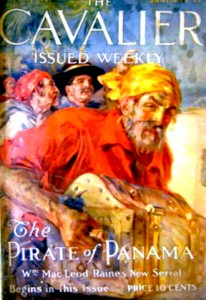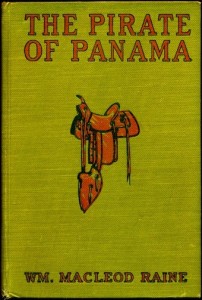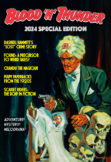EDitorial Comments
William MacLeod Raine’s THE PIRATE OF PANAMA (1913)
Readers of Blood ‘n’ Thunder are aware that I have a special interest in pulp yarns adapted for Hollywood movies of the silent and early-talkie eras. So you can imagine how eager I was to tackle a recently acquired copy of William MacLeod Raine’s The Pirate of Panama, which was serialized in three January 1914 issues of The Cavalier before seeing publication in book form by G. W. Dillingham Company later that year: I knew this novel to be the source for a 1929 Universal chapter play of the same title.
Raine had been writing fiction since the closing years of the previous century and was a regular contributor to such prominent periodicals as The Argosy, The All-Story, Pearson’s Magazine, People’s Magazine, and The Popular Magazine. The latter published several of his early Western novels, including Wyoming and A Texas Ranger. In fact, by 1914 Raine was already well known as a top hand in the Western genre, so The Pirate of Panama represented quite a departure even at that relatively early point in his career.
 The story is narrated by its protagonist, Jack Sedgwick, a young San Francisco lawyer who craves adventure. One morning, while on his way to work, Jack glances up at an apartment building and sees a young woman arguing with a somewhat older man over a piece of paper. She flings this document out the second-floor window rather than surrender it to her agitated tormentor. Sedgwick watches the paper flutter downward and picks it up. A cursory examination reveals it to be a treasure map. Shocked by this discovery, the young lawyer continues his commute in something of a trance.
The story is narrated by its protagonist, Jack Sedgwick, a young San Francisco lawyer who craves adventure. One morning, while on his way to work, Jack glances up at an apartment building and sees a young woman arguing with a somewhat older man over a piece of paper. She flings this document out the second-floor window rather than surrender it to her agitated tormentor. Sedgwick watches the paper flutter downward and picks it up. A cursory examination reveals it to be a treasure map. Shocked by this discovery, the young lawyer continues his commute in something of a trance.
The man in the window, having seen this, dashes downstairs and pursues Jack, who eludes him by hopping aboard a streetcar. Raine contrives — rather unconvincingly, I might add — a subsequent meeting of the two at a local restaurant, where the deep-dyed villyun recognizes Sedgwick as the retriever of the map. Once again he gives pursuit, once again the lawyer evades him.
Returning to his office, Jack is surprised by the presence of a visitor: the lady in the apartment-house window, who introduces herself as Evelyn Wallace. The map, she explains, was procured by her late father in his youth. It gives the location of buried treasure in Panama. Evelyn identifies the villain as her second cousin, a half-Scotch, half-Russian soldier of fortune named Boris Bothwell.
At this point — another contrived coincidence — the suavely sinister Bothwell turns up at Jack’s office and none too subtly demands the map. Like any good, red-blooded pulp-fiction hero Sedgwick refuses, gallantly casting his lot with the pretty girl instead. Boris warns Jack that he’s in for trouble and storms out. After thanking her champion, Evelyn gratefully accepts his offer of assistance in finding and retrieving the treasure.
In short order Jack rounds up an excitement-loving crew of compatriots led by wealthy Sam Blythe, who allows the expedition to sail aboard his yacht Argos. One of Sam’s acquaintances, a two-fisted ex-cowpuncher named Ted Yeager, comes along for the fun of it. Unbeknownst to any of them at the voyage’s beginning, the vessel also carries two stowaways: Jack’s office boy Jimmie and Boris Bothwell. The latter, having formed an alliance with one of the crew members, foments a mutiny once the ship gets underway.
A big chunk of the book is devoted to the struggle between rival factions vying for control of the Argos while it is en route to Panama. The mutineers are finally crushed after making several attacks and Bothwell is imprisoned in a cabin. Raine’s descriptions of the pitched battles are quite vivid and leave little to the imagination.
Not surprisingly, upon finally reaching the Panamanian shore Sedgwick and his friends run into more difficulty: Shifting sands have obscured landmarks pointing to the treasure’s burial spot; when found the unearthed chest turns out to be empty; and Bothwell escapes with the aid of a former co-conspirator. Jack, Sam, Ted and their allies eventually locate the loot, and Boris confronts the young lawyer one last time. In the knock-down, drag-out brawl that follows, Sedgwick is nearly bested before Bothwell is shot in the back by a disgruntled mutineer. Needless to say, Jack and Evelyn have fallen madly in love with each other, and all’s well that ends well.
Having enjoyed the Raine Westerns I’ve read, I had surprisingly mixed feelings about The Pirate of Panama. The writing is uncharacteristically uneven for this author; much of the book reads like a dime novel. The romantic interludes are particularly cloying, and there’s way too much dialogue of the curse-you-Jack-Dalton variety. Sedgwick is a personable protagonist, but his comrades Blythe and Yeager are more interesting and capable characters.
 Universal Pictures adapted The Pirate of Panama into a 12-chapter serial in 1929. It starred Jay Wilsey (the erstwhile “Buffalo Bill Jr.” of countless Westerns) as Jack, Natalie Kingston as Evelyn, and Al Ferguson as Boris. Although the serial is a lost film, I matched episode synopses published contemporaneously in Universal Weekly with the novel to see how much of Raine’s work survived in the scenario written by George Morgan and Arthur Henry Gooden. Basically, the serial’s first three chapters — constituting a fourth of the total running time — track events depicted in the first two thirds of Raine’s novel. Morgan and Gooden then spin off a series of digressions, padding out their narrative and only returning to the original yarn for the last chapter. I suspect the novel came to Universal’s attention when Grosset & Dunlap, which in the late Twenties was reprinting Raine’s Westerns in 75-cent editions, issued their version of the Dillingham hardcover edition. Apparently, G&D’s art director didn’t realize that Pirate of Panama wasn’t a Western, as the cloth cover bore the same “saddle” graphic found on Raine’s horse operas published by the company.
Universal Pictures adapted The Pirate of Panama into a 12-chapter serial in 1929. It starred Jay Wilsey (the erstwhile “Buffalo Bill Jr.” of countless Westerns) as Jack, Natalie Kingston as Evelyn, and Al Ferguson as Boris. Although the serial is a lost film, I matched episode synopses published contemporaneously in Universal Weekly with the novel to see how much of Raine’s work survived in the scenario written by George Morgan and Arthur Henry Gooden. Basically, the serial’s first three chapters — constituting a fourth of the total running time — track events depicted in the first two thirds of Raine’s novel. Morgan and Gooden then spin off a series of digressions, padding out their narrative and only returning to the original yarn for the last chapter. I suspect the novel came to Universal’s attention when Grosset & Dunlap, which in the late Twenties was reprinting Raine’s Westerns in 75-cent editions, issued their version of the Dillingham hardcover edition. Apparently, G&D’s art director didn’t realize that Pirate of Panama wasn’t a Western, as the cloth cover bore the same “saddle” graphic found on Raine’s horse operas published by the company.
Are there any other William MacLeod Raine fans out there? If so, send me a comment and let us know which of his stories you particularly like — or dislike.
Recent Posts
- Windy City Film Program: Day Two
- Windy City Pulp Show: Film Program
- Now Available: When Dracula Met Frankenstein
- Collectibles Section Update
- Mark Halegua (1953-2020), R.I.P.
Archives
- March 2023
- July 2021
- May 2021
- March 2020
- February 2020
- December 2019
- November 2019
- October 2019
- September 2019
- August 2019
- May 2019
- April 2019
- March 2019
- February 2019
- December 2018
- November 2018
- October 2018
- August 2018
- June 2018
- February 2018
- December 2017
- October 2017
- September 2017
- August 2017
- May 2017
- April 2017
- February 2017
- September 2016
- August 2016
- July 2016
- June 2016
- November 2015
- October 2015
- September 2015
- August 2015
- July 2015
- June 2015
- May 2015
- April 2015
- March 2015
- February 2015
- January 2015
- August 2014
- July 2014
- June 2014
- May 2014
- April 2014
- January 2014
- December 2013
- September 2013
- August 2013
- July 2013
- June 2013
- May 2013
- April 2013
- March 2013
- February 2013
- January 2013
- December 2012
- October 2012
- September 2012
- August 2012
- July 2012
- June 2012
- May 2012
Categories
- Birthday
- Blood 'n' Thunder
- Blood 'n' Thunder Presents
- Classic Pulp Reprints
- Collectibles For Sale
- Conventions
- Dime Novels
- Film Program
- Forgotten Classics of Pulp Fiction
- Movies
- Murania Press
- Pulp People
- PulpFest
- Pulps
- Reading Room
- Recently Read
- Serials
- Special Events
- Special Sale
- The Johnston McCulley Collection
- Uncategorized
- Upcoming Books
- Western Movies
- Windy City pulp convention
Dealers
Events
Publishers
Resources
- Coming Attractions
- Field Guide to Wild American Pulp Artists
- MagazineArt.Org
- Mystery*File
- ThePulp.Net




